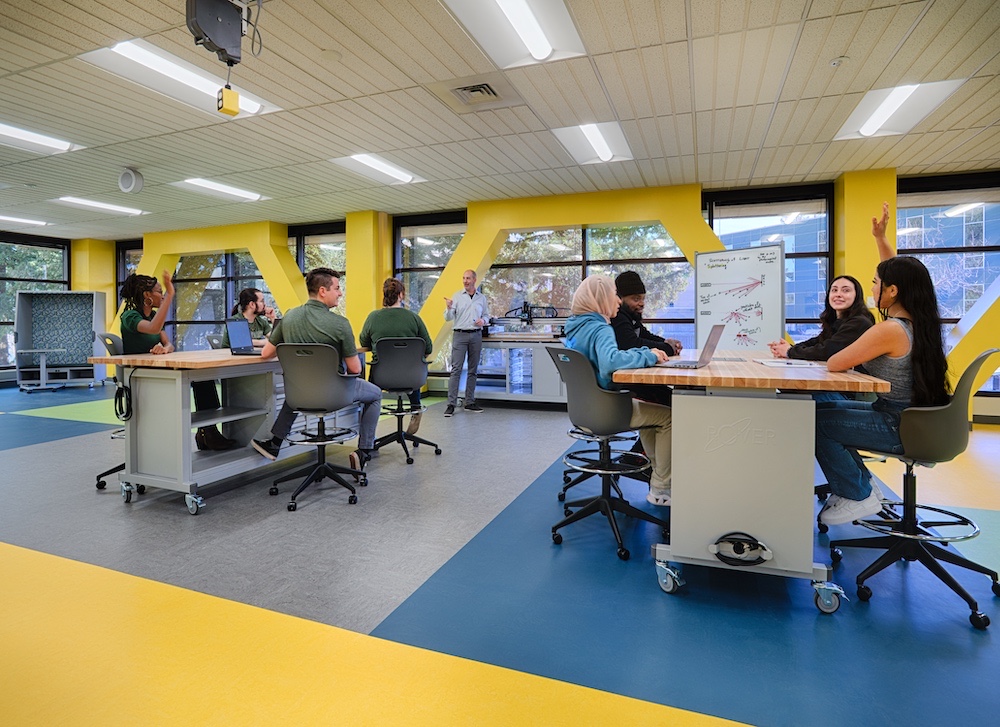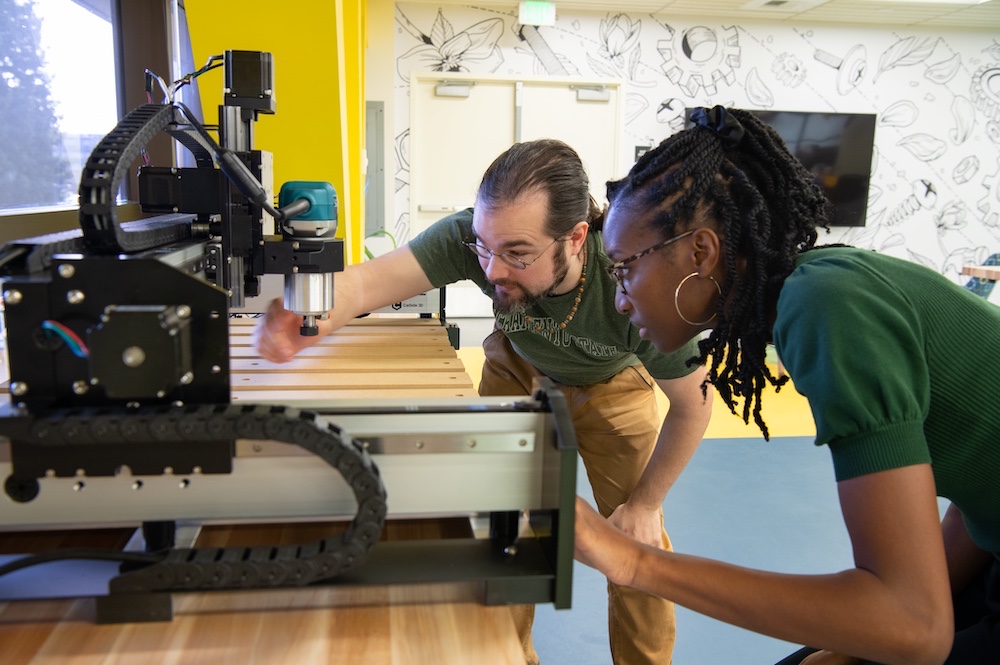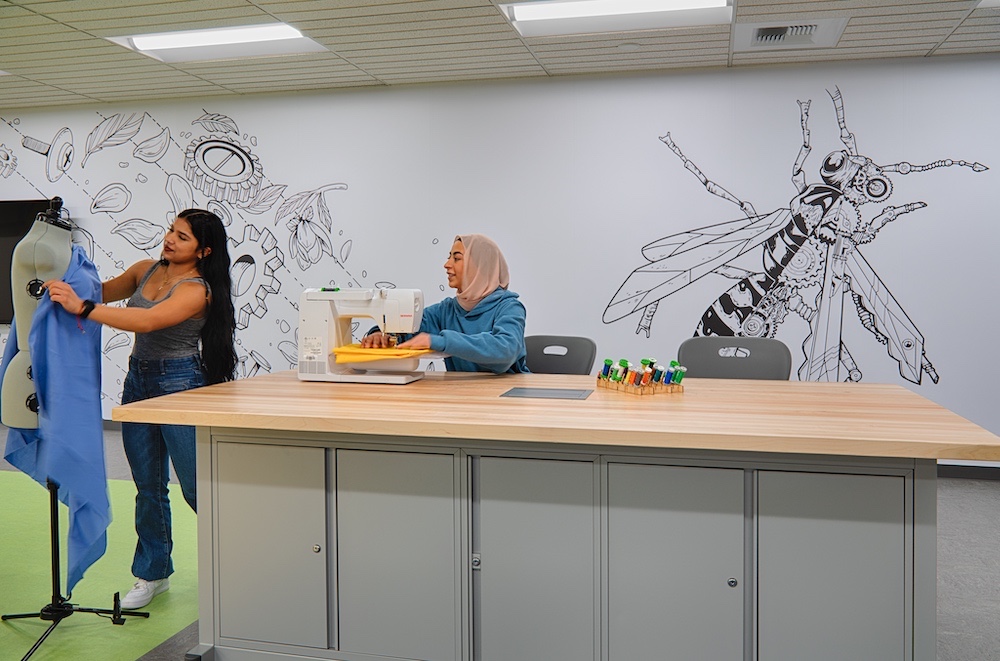We think of libraries as being in the book business, but in reality, libraries are in the business of thinking, learning, and doing. With this ethos in mind, the Sacramento State University Library planned and affordably built StingerStudio, a brand-new makerspace that encourages our students to develop new skills, solve complex problems, and discover real-world solutions. This space, an extension of our classroom instruction, is how we prepare our students for the rapidly changing work of the 21st century. Here I share an overview of who we are and why this space in inherent to our continued success as an impactful campus.
Sacramento State, with nearly 31,000 students, is the 6th largest of the 23 campuses in the California State University system. According to U.S. News & World Report (2022) it is the 4th most diverse campus in the Western U.S. With 34% of our students recognized as first generation, 54% receiving financial aid, and 49% Pell Grant eligible – the institution’s impact reverberates throughout the capital region where 1 in 18 adults have graduated from Sacramento State. We are federally recognized as an Asian American & Native American Pacific Islander Serving Institution (AANAPISI) and a Hispanic Serving Institution (HSI).
Setting our diverse student body up for success with cutting edge skill sets and a solid education positively impacts Sacramento, the Capital City of California; the 5th largest economy in the world. Doing well by our students secures the future of our local businesses and neighborhoods.

Stinger Studio Mission: Making – Inclusive & Accessible – for All
The University Library partnered with the design team at Lionakis and Haskell Education’s Cristel Hutchinson to design a 4-room, close to 6,000 sq ft space that provides students with the opportunity to develop skills, experiences, and connections that prepare them for careers in the knowledge-driven economy. Future employers desire skilled workers – ones that are adaptive and resourceful. The makerspace learning environment is one of inquiry and experimentation; it is learner-driven and promotes creative and critical thinking.

Here students develop positive learning traits like initiative, flexibility, persistence, and collaboration. At Stinger Studio, students learn to create through self-led curiosity. A maker education encourages students as they develop critical thinking, resourcefulness, imagination, tenacity and collaboration skills. Through making, students are empowered with a sense of agency.
Stinger Studio is a community where students feel like they belong. This space is uniquely cross-disciplinary, bringing together students and faculty from across the campus. Hosted in the University Library, the makerspace is open and accessible to all students.

Innovation and Creation Starts Here
The four rooms were reclaimed from their previous use as media and microforms storage and use spaces. Amazingly, the most attractive and sunlit rooms were used for 16mm, VHS, and DVD storage. Putting our student’s needs first, we affordably designed a space that is social, public, and focused on shared learning. Learners begin their visit in our soft-arts space where campus ID-holders check-in and are directed to equipment training or use, dependent on their expertise. Sewing and embroidery machines, vinyl cutters, several couches, comfortable seating, and social space provides a welcoming entry space. The largest and brightest room holds the majority of our 3D printers, laser cutters, a Computer Numerical Control (CNC) machine and much more. An array of Haskell Education maker furniture; tables, seating, and flexible work spaces allow for the scheduling of classes or drop-in sessions. Lionakis designed a space with expanded power sources, improved LED lighting, a commercial sink/facet, and a high-end wall system that allows for bins and tools to be hung. The cherry on top was a gift of a mural by the amazing artist Candice Ciesla of a steampunkish hornet. It has become the favorite University Library selfie background.
A third room holds all of our virtual, extended, and augmented reality equipment. The campus recently received a State of California grant of $300,000 to design and outfit this room with the burgeoning artificial intelligence market in mind. Sacramento State is developing a dedicated space for faculty to learn AI/DA/XR technologies and to incorporate it into their classroom and course materials across disciplines; thereby, giving students an opportunity to develop in this growing and rapidly evolving environment.

The fourth room is currently being used as a classroom for tool trainings and as a break-out space for work groups or activities that need more room to spread out. The location allows for just-in-time movement and allows for multiple teaching and learning activities to happen at the same time throughout the StingerStudio.
We use design thinking where students collaborate to make 3D-printed models of homes for an architectural design class. Our students in the Fashion Merchandising & Management classes use embroidery and digital sewing machines to prepare for careers in the global fashion industry. And with virtual reality our students look into the human body to visualize how physiological systems work; helping them become better doctors, scientists, and researchers.
StingerStudio is adjacent to the Carlsen Center for Innovation and Entrepreneurship, forming a unique learning ecosystem that supports collaboration and entrepreneurism at Sacramento State. Any student can take a real-life problem, develop a prototype or solution, and learn about what it takes to bring a product to market in one place.
Sac State’s StingerStudio has only been open since March 2023. With over 5,000 visits, it is bringing together students and faculty from across the campus and we can’t wait to see how use of this space ripples into our greater community.

